Did you know the Great Pyramids of Giza are the only survivors of the Seven Wonders of the Ancient World? These structures continue to awe those who have the privilege of witnessing them. Located on the Giza Plateau, the site boasts the Pyramid of Khufu, known as the Great Pyramid of Giza. It also features the Small Pyramid of Khafre and the Pyramid of Menkaure.
The ancient Egyptians constructed several smaller structures, called the Queen’s Pyramids , for royal consorts. These structures surround the main pyramids, adding to the site’s grandeur.
Core Themes about The Great Pyramids Of Giza:
- The idea of pyramids in Ancient Egypt: Pyramids were grand tombs for kings in ancient Egypt. They showcased advanced engineering and deep spiritual beliefs. Their enigma and grandeur have captivated many for generations.
- Architectural Marvel of Ancient Egypt: The Great Pyramid of Giza stands as a testament to ancient engineering prowess. The Pyramids of Khafre and Menkaure further highlight this skill. Built with over 2.3 million stone blocks, they were once covered in white limestone for a gleaming finish.
- Ancient Egyptians constructed the pyramids during the Fourth Dynasty of Egypt (2600–2500 BC), marking a significant era in their history and spirituality. These structures served as final resting places for pharaohs like Khufu. This underscores their profound belief in the afterlife and the importance of the Giza Plateau.
- Skilled Workers, Not Slaves: The construction process involved 20,000–30,000 skilled laborers. This team included stonecutters, engineers, and laborers, who resided in organized communities. This dispels the myth of slave labor in pyramid construction.
- Strategic Construction and Material Transport: The use of local limestone and granite from Aswan for the inner chambers demonstrates advanced planning. The Nile River played a crucial role in transporting these materials, showcasing the ingenuity of ancient Egyptians.
- Cultural and Global Recognition: The site boasts iconic structures like the Great Sphinx, Valley Temple, and Solar Boat Museum. It is also a UNESCO World Heritage Site. It continues to inspire awe in visitors, much like it did for the Greek historian Herodotus.
The concept of the pyramids in ancient Egypt

- What is a Pyramid ?
- What’s the most historic thing the ancient Egyptians ever built?
Ancient builders created pyramids as tombs using stone masonry, with four triangular sides. These monuments were key to royal funerary complexes from the 3rd Dynasty to the Second Intermediate Period. The engineering and spiritual beliefs of that era are revealed through these structures. The Egyptian pyramids continue to fascinate tourists and scholars with their mystery and scale.
Think you know the Giza pyramids? These facts might surprise you!
1-The Structure of the Great Pyramids of Giza

- How big are the Pyramids of Giza?
- How many bricks did the ancient Egyptians use in their construction?
- How much does each brick weigh?
The Pyramids of Giza stand as impressive structures. The Great Pyramid, built for Pharaoh Khufu, had a base of about 756 feet (230 meters) on each side. It originally stood at 481 feet (147 meters) tall but now reaches 449.5 feet (137 meters) due to erosion. The pyramids of Khafre and Menkaure are smaller, with Khafre’s pyramid measuring about 707 feet (216 meters) per side and originally standing 471 feet (143 meters) tall.
Menkaure’s pyramid is 356.5 feet (109 meters) per side and originally reached 218 feet (66 meters) in height.
The Great Pyramid of Khufu was built with about 2.3 million stone blocks, including limestone and granite. Many of these blocks weighed between 2.5 and 15 tons. Originally, the pyramid was covered in shiny white limestone casing, reflecting sunlight and making it shine brightly. This is a testament to ancient architecture.
2- The Era Of Building The Pyramids Of Giza.
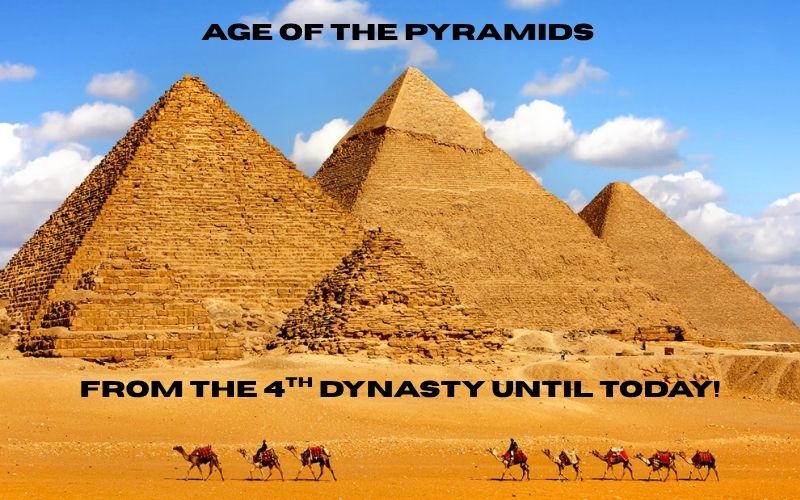
- When did the ancient Egyptians build the pyramids?
- What is the “ Age of the Pyramids” ?
The Giza Pyramid Complex was built during the Fourth Dynasty of the Old Kingdom, between 2600 and 2500 BC. This period is known as the “Age of the Pyramids.” The reigns of Khufu, Khafre, and Menkaure defined this era. Their legacy is seen in the massive structures they commissioned for their afterlife passage.
3- Giza Great Pyramid Construction Timeline
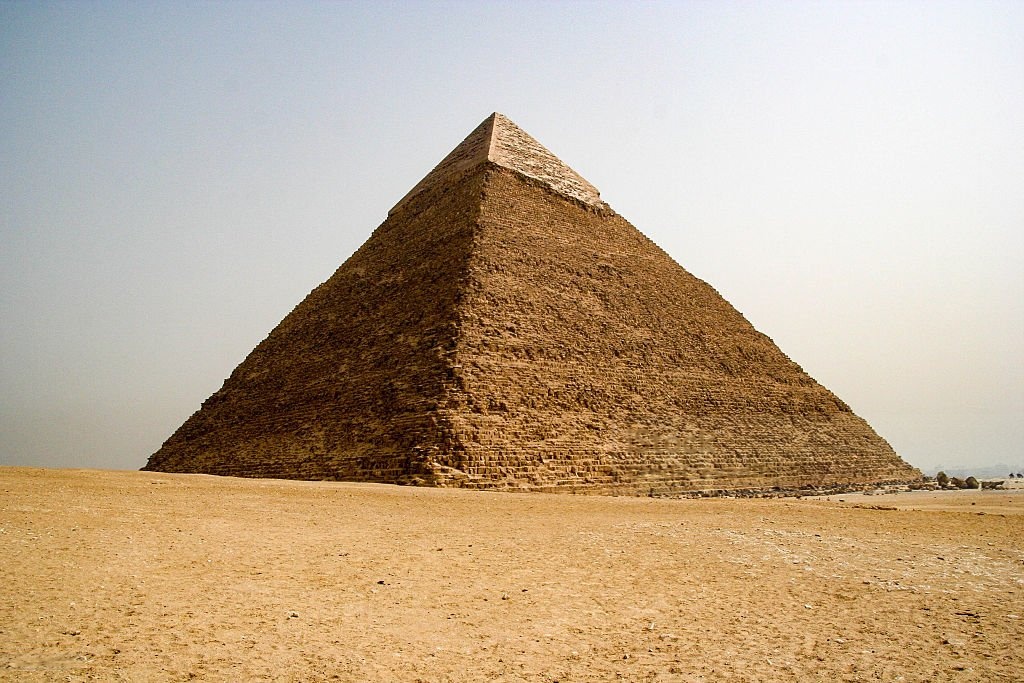
- How Long Did It Take to Build The Great Pyramid of Giza?
The Great Pyramid of Giza, commissioned by King Khufu, took around 20 years to complete. Ancient Egyptians used smart design and engineering, like ramps and levers. They had large, skilled workforces to help.
4- The Builders Behind Egypt’s Great Pyramids
- How many people built the pyramids of Giza?
- Who Built the Pyramids?
It’s estimated that 20,000 to 30,000 workers were involved in constructing the pyramids. These individuals included stonecutters, engineers, architects, and support staff. Contrary to the myth of slave labor, evidence suggests workers lived in organized settlements and were well-fed. Their efforts in building the Egyptian pyramids stand as a testament to humanity’s architectural prowess.
5- Transportation of the Pyramids Building Stones
- What types of stones did the ancient Egyptians use to build the pyramids?
- How did workers transport the stones used to build the pyramids?
- Where did the materials for the pyramids come from?
The majority of the limestone casing stones were sourced from quarries near the Giza Plateau. The granite for the burial chambers, however, originated from Aswan, over 800 kilometers away. Workers successfully floated these granite blocks down the Nile River. This showcases the meticulous planning and execution of the ancient Egyptians in undertaking such monumental projects.
6- Inside the Pyramids: Tombs, Chambers, and Secrets

- What is Inside the Pyramids?
- What will you find inside the pyramids of Giza?
- Can you go inside pyramids?
Inside the Great Pyramid of Khufu, visitors will encounter the King’s Chamber, Queen’s Chamber, and the Grand Gallery. The Grand Gallery, with its intricate design, remains a subject of ongoing research. These internal structures were designed as sacred spaces for the pharaoh’s journey into the afterlife. The Pyramid of Khafre and Pyramid of Menkaure also feature similar burial chambers.
7- The Significance of the Giza Plateau

- Why did the ancient Egyptians choose the Giza Plateau?
- Why did the ancient Egyptians choose the Giza Plateau for the Pyramids?
- What makes the Giza plateau perfect for large buildings?
The Giza Plateau was chosen for its spiritual, practical, and geological advantages. It is located on the Nile’s west bank, symbolizing the land of the dead in Ancient Egypt. The bedrock is solid and stable, making it ideal for large structures. Its proximity to Memphis and local quarries further enhances its suitability for such monumental projects.
8- Additional Wonders Around the Pyramids
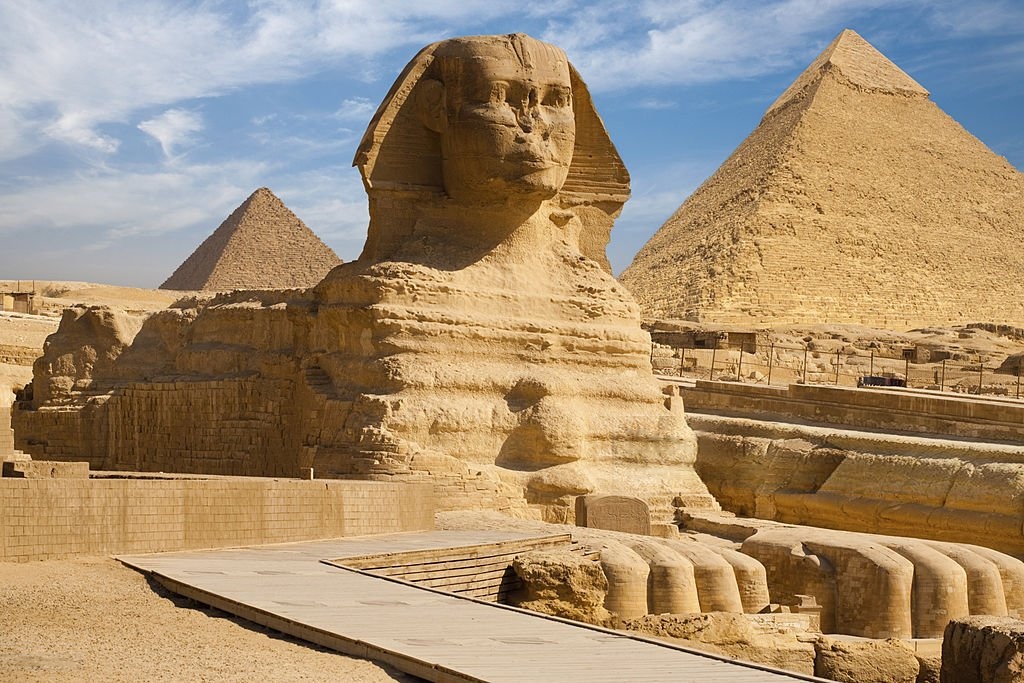
- What is around the pyramids?
- What’s near the pyramids?
Near the Pyramid of Khafre, the Valley Temple played a crucial role in funerary rituals, particularly in mummification. Guarding the complex is the legendary Great Sphinx, believed to represent Pharaoh Khafre. Next to the Great Pyramid of Giza, the Solar Boat Museum holds a well-preserved wooden ship. The ancient Egyptians buried this ship to take Khufu into the afterlife with his belongings.
9- Historical Recognition and Legacy
- Who first wrote about the pyramids?
- Does UNESCO protect the pyramids?
- What steps will researchers and authorities take in the future to preserve Egypt’s ancient history?
Herodotus, a Greek historian, was amazed by the pyramids, calling them wonders of the world. Today, the Giza Pyramid Complex is a UNESCO World Heritage site. The upcoming Grand Egyptian Museum will be the world’s largest archaeological museum. It will play a key role in preserving and showcasing Egypt’s ancient history.
More hidden Egyptian pyramids you probably haven’t heard of
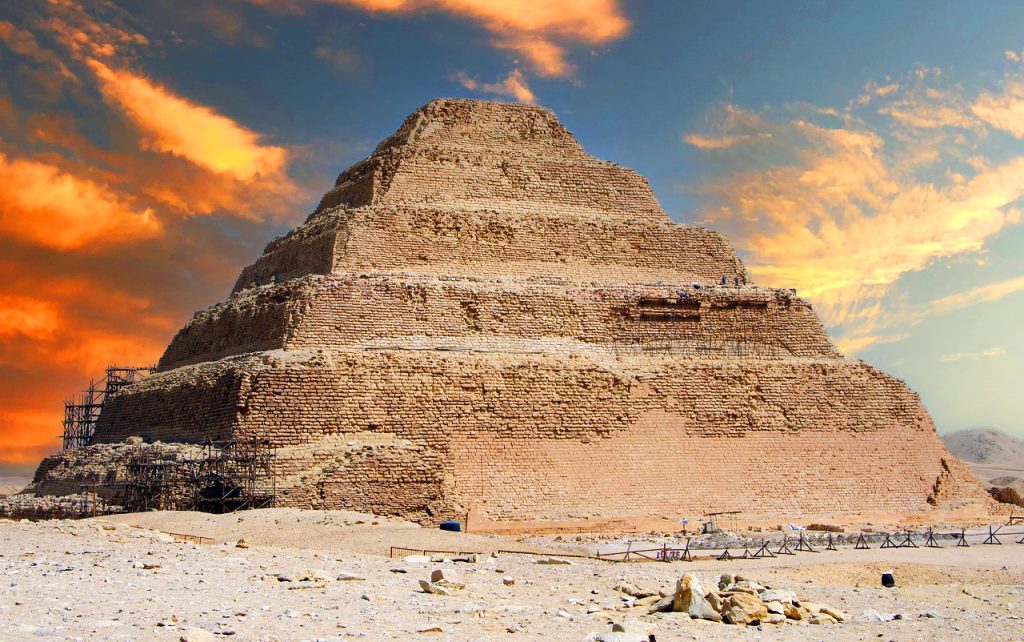
While the Pyramids of Giza are famous, Egypt has at least 118 Egyptian pyramids that are less known. These hidden pyramids are a treasure trove of history, showing the evolution of ancient Egyptian architecture, politics, and spirituality.
The Step Pyramid of Djoser at Saqqara and Sneferu’s Bent and Red Pyramids are just a few examples. They mark the beginning of royal funerary architecture. This period, known as The Age of the Pyramids (2635–1780 BC), was a golden era. Pyramids were both tombs and symbols of divine kingship.
What Makes These Hidden Pyramids Special?
- Architectural Innovation: Early pyramids evolved from step designs to smooth-sided structures, leading to Giza’s iconic forms.
- Ancient builders used precise geometry and aligned pyramids with celestial bodies, reflecting deep spiritual beliefs.
- Royal Legacy: Pharaohs like Djoser, Sneferu, and Amenemhat built these monuments to assert their divine status and leave a lasting legacy.
- Explore historic sites beyond Giza: Visit places like Saqqara, Dahshur, Abusir, and Lisht, where dozens of unique pyramids still stand.
Curious minds and history enthusiasts can explore these overlooked pyramids. They offer a deeper, more diverse look into ancient Egypt’s cultural heritage.
Things to pack up for your Giza pyramids tour
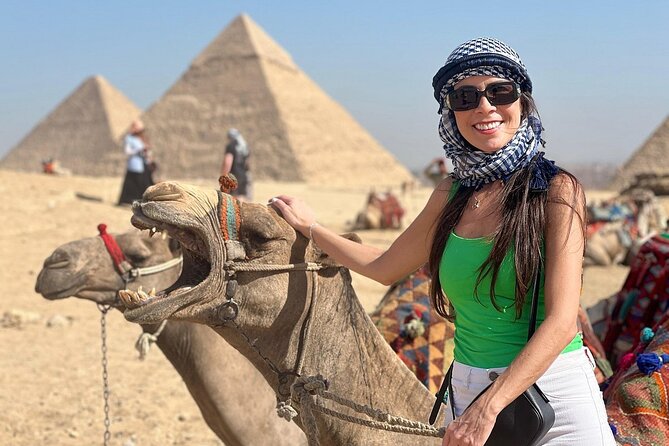
- What to pack for you Egypt Giza pyramids Tour?
- What to wear when visiting the Pyramids of Giza?
| Item | Purpose |
|---|---|
| Light, breathable clothing | Stay cool in hot desert climate |
| Comfortable walking shoes | Walk long distances, handle uneven terrain |
| Wide-brimmed hat or cap | Protects face and head from sun |
| Sunglasses | Shields eyes from sunlight and glare |
| Sunscreen (high SPF) | Prevents sunburn and UV damage |
| Reusable water bottle | Keeps you hydrated |
| Passport/ID & tickets | Required for entry and identification |
| Cash (Egyptian pounds) | Tips, small purchases, local vendors |
What to Remember…

The Great Pyramids of Giza are more than just big buildings. They symbolize a civilization that excelled in architecture, astronomy, and spiritual thought. The Giza Plateau offers a timeless experience.
You can see the casing stones, visit the Queen’s Pyramids, and check out the Solar Boat Museum. It takes you through one of the most interesting parts of human history.
So, what are you waiting for? Book your trip now with us. Stand in the shadows of giants—from the Valley Temple to the towering Great Pyramid of Khufu.
